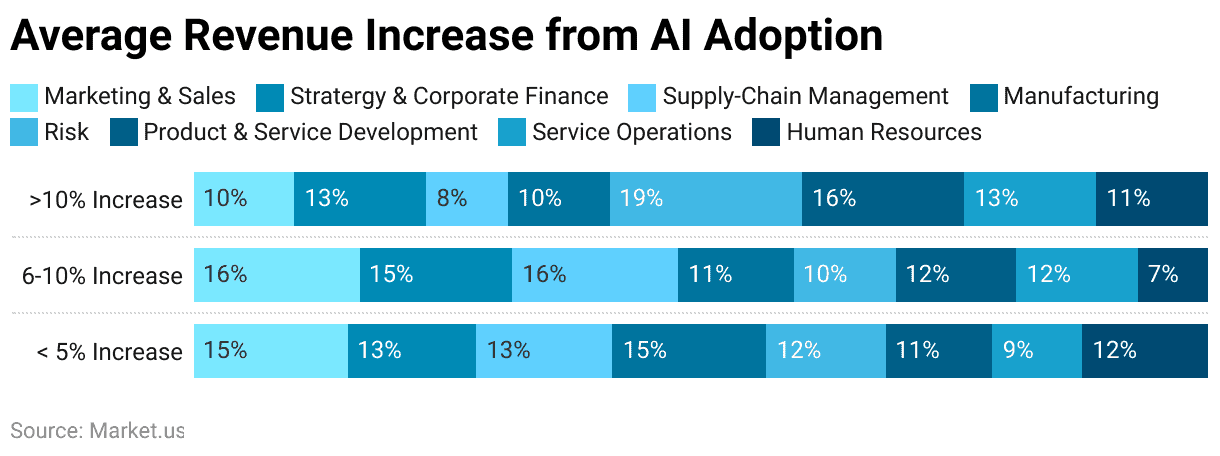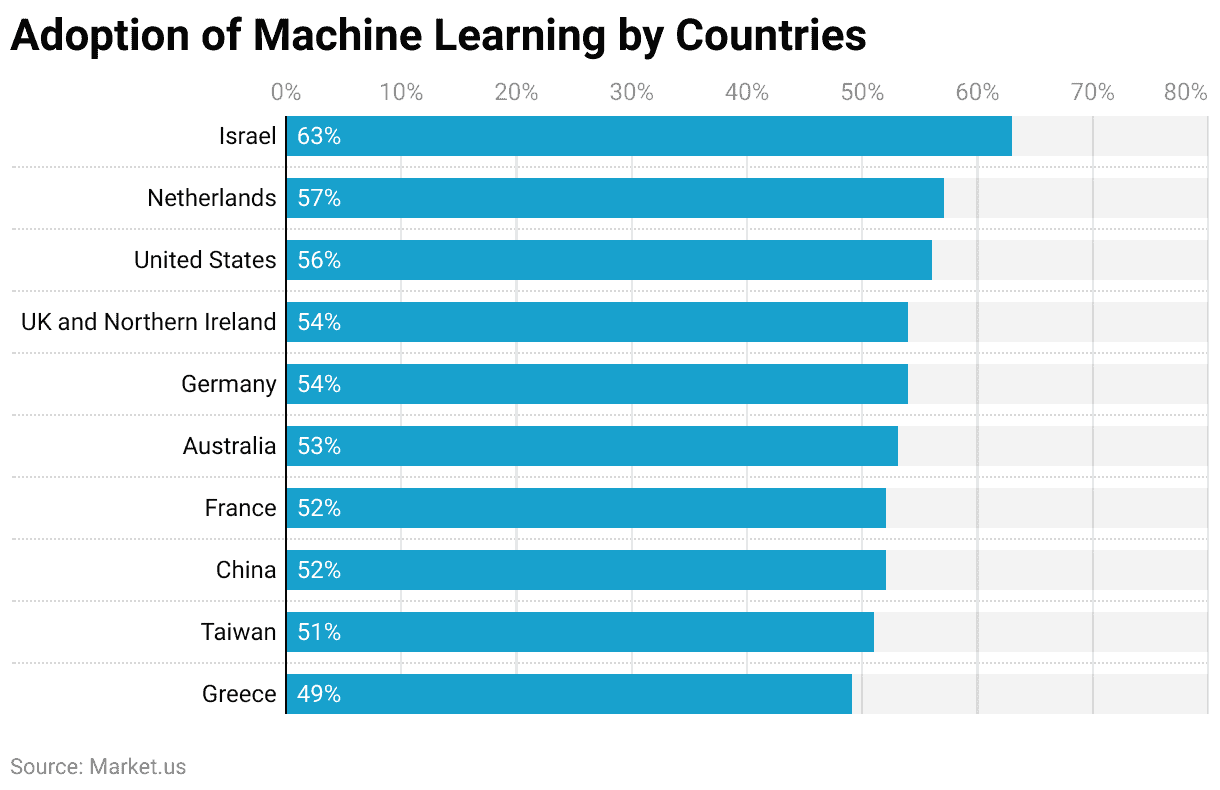Table of Contents
- Machine Learning Statistics 2023
- Detailed Machine Learning Statistics 2023
- Machine Learning Adoption by Companies
- Machine Learning in Voice Assistants
- Machine Learning Benefits Statistics
- Machine learning for healthcare
- Employment Predictions from 2022 Through 2032
- Average Compensation of Jobs Using Machine Learning Skills
- Technology Trends
Machine learning statistics show that it is still in its testing phase. Professionals need to grow their expertise for its sustainability.
“According to Market.us, the Machine Learning Market is expected to grow at a CAGR of roughly 39.1% over the next 10 years and will reach US$ 582.4 Bn in 2032, from US$ 21.5 Bn in 2022.”
Machine Learning Statistics 2023
- To make the most of massive data sets, 8% of firms utilize machine learning, deep learning, data analysis, and natural language processing.
- Security is a top priority for any business.
- A.I. accounts for around 25% of I.T. By 2026, the hardware market is anticipated to be worth $87.68 billion.
- COVID has resulted in a 12% decrease in A.I. chip-making enterprises.
- By 2025, the American deep-learning market is anticipated to be worth $80 million.
- 91.5% of the world’s largest corporations invest in artificial intelligence.
- Senior executives personally oversee 75% of artificial intelligence projects.
- Tesla’s self-driving vehicles traveled more than 188 billion miles in the fourth quarter of 2019.
- When used multiple times over a six-month period, voice assistance usage increased by 5%.
Detailed Machine Learning Statistics 2023
- Machine Learning, Deep Learning, and Natural Language Processing are used by 48% of firms to successfully use massive data sets.
- One in every three I.T.
- Every second, modern enterprises generate gigabytes of data.
- Machine learning algorithms are currently found in many software programs.
- This enables individuals to better comprehend the significance of specific data to a company.
Security is a primary responsibility of any business. Approximately 25% of IT professionals want ML (Machine Learning) to be used for this resolution.
- Additionally, 16% feel machine learning is efficient and successful for marketing and sales.
- Although the proliferation of smart devices (computers, smartphones, tablets, and so on) is beneficial to businesses, security concerns are rising in importance as hackers seek new ways to infiltrate new technology.
- Although the proliferation of smart devices is beneficial to businesses, security concerns are growing as hackers seek new ways to exploit new technology. Machine learning algorithms appear to be an excellent solution to the growing security challenges.
- Marketing & sales are also a place where companies use ML algorithms. They do this for targeted marketing which has so far proven more efficient than blanket advertising.
Machine Learning does not show significant cost reductions, but it does show revenue increases. According to a survey, 80% of respondents believe that artificial intelligence is increasing revenue. Machine Learning (ML), which increases revenue, is becoming more popular.
- It appears that ML is growing income rather than cutting costs.
- While this isn’t necessarily a bad thing, many I.T. professionals and businesspeople are perplexed that these two data aspects are not occurring concurrently.
- The rise in revenue may compensate for the lack of cost-cutting measures.
- It’s encouraging to hear that 80% believe machine learning is assisting them in increasing revenue.
The A.I. The Hardware Market Value is Expected to Climb Up to $87.68 billion by 2026.
- This is anticipated due to a CAGR (compound annual growth rate) of 37.60% between 2019 and 2026.
- While many people believe that artificial intelligence is merely software, the hardware components are equally crucial.
- Today’s A.I. is primarily reliant on computer power. As a result, A.I. hardware is projected to grow in importance in the future.
- The majority of AI programs are now employed in chatbots, factory equipment, and other applications.
Machine Learning Adoption by Companies
According to a recent report on machine learning, adoption has reached unprecedented heights. The adoption of ML has accelerated as businesses seek to use the technology to stay ahead of the competition. The banking sector has been one of the most enthusiastic users of AI technologies.
Machine learning is used in these tools to evaluate data and discover insights. Machine learning skills such as risk management, performance analysis, reporting, and automation are propelling development. Here are some statistics on machine learning adoption.
- Half of those polled stated their organization had implemented AI in at least one area.
- One-third of IT executives plan to employ for business analytics.
- 25% of IT leaders intend to use it for security.
- 16% of IT executives want to use it for marketing and sales.
- The top three corporate functions adopting AI in 2020 are the same as in 2019: sales and marketing, service operations, and product/service development.
- AI adoption is frequently related to greater revenue. Cost savings aren’t usually reported. For example, 80% of respondents stated that AI assisted in increasing revenue.
- AI and machine learning have the potential to boost global GDP from now until 2030 by 14%.
- Scaling up (43%) and modifying the ML model (41%) are the biggest challenges to machine learning adoption.
(McKinsey-2020, Statista[2019, 2021], WSJ, 2019)

Machine Learning in Voice Assistants
The term “machine learning” refers to a subset of “deep learning,” which is based on machine learning. This is the technology that powers Siri, Echo, and Google Assistant. Following the explosion of mobile technology, consumers’ interest in voice assistants has grown. Look at the numbers below to see how this has progressed.
- Around 3.25 billion people worldwide use voice-activated assistants and search engines, which is almost half the population of the world.
- Global voice assistant usage during COVID-19 rose by 7%.
- People began to use voice assistants more often because of the pandemic. The number of people who use it daily rose from 20% in December 2019 to January 2020 (Voicebot.ai 2020) to 25% in March and April 2020.
- In 2020, voice assistants will be used by 128 million Americans, an increase from 115.2 million in 2019. ()
- Voicebot.ai (2019) found that 80.5% of under-30 consumers used a voice assistant for their smartphones, compared to only 60.5% in the older age groups.
- Voicebot.ai reports that 74.7% (of consumers aged 30-44) use voice assistants for their smartphones. 68.8% (of consumers aged 45-60%) do the same.
- By 2023, it is expected that 8 billion people worldwide will use voice assistants.
- The estimated value of the global market for natural language processing will be $43 billion.
(Source: Review42-2021, AUM-2020, Statista)
Top Countries Considered Early Adopters of Machine Learning Methods and Tools
- Israel
- Netherlands
- United States
- UK and Northern Ireland
- Germany
- Australia
- France
- China
- Taiwan
- Greece

Machine Learning Benefits Statistics
- 38% of businesses reduced their business costs by implementing machine learning.
- Machine learning is assisting 34% of businesses in improving customer service.
- Machine learning assisted 27% of businesses in detecting and reducing fraud in their operations.
- Machine learning is projected to have saved Netflix $1 billion.
- Using machine learning reduces Google Translation errors by 60%.
- During a pandemic, machine learning predicted the mortality of Covid-19 patients 92% of the time.
- AI can assist in avoiding 81% or more of cybercrime.
- 65% of business owners believe that it helps them make better decisions.
- Chatbots are preferred by 45% of customers over live operators as the primary source of customer assistance.
- AI is anticipated to increase business profits by 38% between 2035 and 2035. This will yield an additional $14 trillion for the same businesses.
Machine learning for healthcare
- In the healthcare sector, machine learning is used for early detection of potential pandemics, ML-based medical diagnosis, disease tracking, and imaging diagnosis.
- Statista estimated the global market in the healthcare sector to be worth $11 billion.
- The clinical trials segment was the top category in which machine learning was applied in the healthcare sector.
- Because of advanced technology created in North America, North America led the regional and global markets for machine learning in healthcare.
Employment Predictions from 2022 Through 2032
- Computer and information science jobs are predicted to expand by 21% between now and 2031. Job opportunities in computer operations will increase by 15%. This is a rapid increase when compared to the overall predicted growth of 5% for all vocations over the same time period.
- Furthermore, an average of 3,300 positions in computer and information science are available each year due to the need for workers to replace those who leave the workforce or change careers.
Average Compensation of Jobs Using Machine Learning Skills
- The median annual compensation for computer and information researchers in 2021 was $131.490, with the bottom 10% getting less than $75,210 and the top 10% earning more than $28,000.
(Source: Bureau of Labour Statistics)
Technology Trends
Foundation models
Large language models have grown in popularity and are expected to remain so for the foreseeable future. The underlying models are artificial intelligence (AI) systems that have been trained on massive volumes of data.
Engineers are attempting to achieve a better degree of comprehension by teaching machines to not only seek patterns but also to acquire knowledge. The basis models are particularly useful for content creation, summarization, translation, coding, and customer support. The foundation models GPT-3, MidJourney, and others are well-known.
The foundation models can also scale quickly and work with data that has never before been seen. This is why they are so amazing at generating. NVIDIA, Open AI, and other leading providers are the main players in this market.
Multimodal machine learning
When a model is used to do tasks like computer vision, natural language processing, or other tasks that involve interaction between the model and the actual world, it frequently relies on only one type of data, whether images or text. In actuality, we perceive the world through a range of senses, including smell, hearing, and touching textures.
Multimodal machine learning implies that we can exploit the fact that humans see our world in a variety of ways (called modality) to construct better models. The AI term “multimodal” refers to the development of ML models that can experience an event in multiple modalities at the same time, just as humans do.
Combining several forms of data and using them in training can aid in the development of an MML. Matching images with audio or text labels can make it easier to identify them. Multimodal machine learning is a relatively new field, which will continue to develop and advance in 2023. However, many people believe it is the key to general AI.
Transformers
Transformers are artificial intelligence architectures that use encoders and decoders to perform transduction or transformation on an input data sequence and transform it into another. Many foundation models make use of transformers. We wanted to draw attention to them separately because they are employed in a variety of other applications. According to reports, Transformers are dominating the AI world.
The Seq2Seq paradigm, often known as transformers, is frequently used in natural language processing and translation. Because they can analyze words in sequences rather than as individual words, transformers outperform artificial neural networks.
Rather than interpreting the statement word by word, a transformer model might apply weights to each word in a sequence. The model then converts the sentence into another language using the weights supplied. Transformer pipelines can be built using Hugging Face, Amazon Comprehend, and other solutions.
Discuss your needs with our analyst
Please share your requirements with more details so our analyst can check if they can solve your problem(s)



